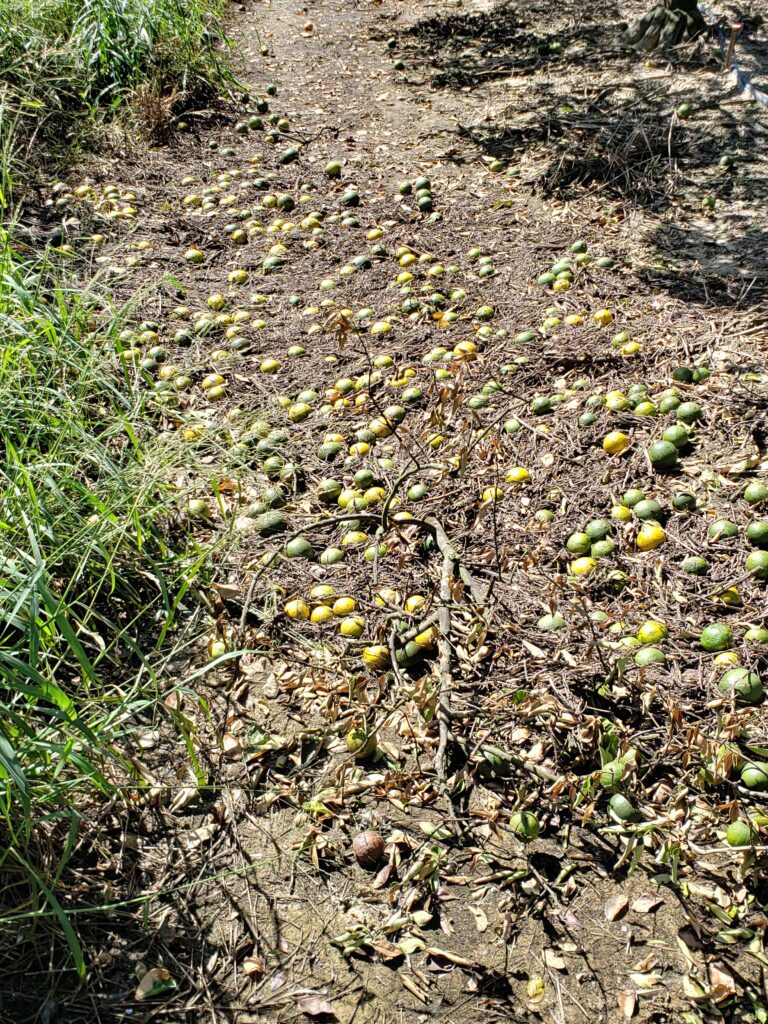Citrus Industry Speculates on Future of Season in Wake of Milton
by PAUL CATALA & JESS McDONALD
Just a month ago, Florida citrus growers were cautiously optimistic about the season ahead. While no one was expecting a drastic change, there were hopes that perhaps greening treatments were starting to even out the losses.
Now, in the wake of a major hurricane and a dismal USDA season forecast, expectations have soured some.

On October 11, the U.S. Department of Agriculture predicted that Florida orange production for the 2024-2025 season would drop 16 percent from last season’s total 18 million boxes to a meager 15 million boxes.
In the weeks leading up to the forecast, many growers said they expected to see production hold steady at about 18 million boxes statewide this season. The effects of citrus greening, previous hurricane seasons, and a decrease in citrus acreage played a key role in those disappointing numbers.
Unfortunately, however, the forecast was not the worst of the news.
The USDA’s official forecast doesn’t account for damage from the two most recent hurricanes, Helene and Milton. That means, the actual production could be much lower.
Kyle Story, a fourth-generation citrus grower and vice president of the Story Companies, says he predicts this season’s production to be between 10 million and 12 million, though it’s still too early to tell. Even that amount, he says, would be made possible through the hard work and camaraderie among growers.
One key factor that could further devastate the citrus crop is fruit drop.
“What we’ve seen so far, and there’s still more to come post-Hurricane Milton, is about half of the early season crop to be lost and about 25 percent of the late-season juice oranges are what we’re thinking we’re going to see,” he says.
The 2023-24 Florida citrus season was steady. The July 2024 report for production of all oranges was up 1 percent from June with 17.96 million boxes, up from the 2023 total of almost 16 million boxes.
The Citrus Research and Education Center in Lake Alfred has provided multiple resources to help growers mitigate damage from the storm. Those resources are available at https://crec.ifas.ufl.edu/citrus-research/resources/hurricane-resources/2024/.
Michael Rogers, director for the center, says fruit drop will be a major factor for this season.
“In the weeks following a hurricane, citrus trees may drop fruit as a result of stresses put on the trees by the high winds,” he says. “While we don’t know how significant the fruit drop will be in coming weeks, UF/IFAS is providing information to Florida citrus growers on practices that can be used in their groves now to minimize this post-hurricane fruit drop.”
Ray Royce, executive director for the Highlands County Citrus Growers Association, says for growers in his county, the damage was not as bad as it was from Hurricanes Ian and Irma.
“We have not seen any significant tree damage or tree loss other than a few places that got hit by tornadoes.”
Despite this, he says, the county did not escape unscathed.
“There is no doubt there has been significant fruit drop at a time when we couldn’t afford to lose a single orange.”
Gene McAvoy, president of Have Gun Will Travel Agricultural Consulting out of La Belle, addressed another concern besides fruit drop.
“Flooding is an issue, especially more for the long term,” he says. “We won’t see the effect immediately in terms of root rot and phytophthora,” but he fully expects those concerns to be amplified down the road.
Matt Joyner, executive vice president and CEO of Florida Citrus Mutual, says despite setbacks from inclement weather, pests, greening, development and other challenges over the past century, the state’s citrus industry remains resilient and redemptive.
He says recent storms, freezes, and the ongoing battle against citrus greening were compounded by Hurricane Milton, making the industry’s recovery efforts more crucial than ever.
Royce says growers are working with crop insurance adjusters to recover from the damage, and he hopes that assistance will be enough.
“It would be great if state or federal programs would be able to help,” he says. “They need to incentivize growers to stay in the game and get trees in the ground.”
Mixed Sentiment
The one-two punch from the hurricanes and the bleak forecast have some speculating on what the future of citrus will look like.
“It’s kind of gloomy out there,” McAvoy says. “There are people who are still committed to the industry. I think you can remain in citrus, but it’s a different ballgame. The management needs to be more intensive and the costs have increased dramatically.”
Despite the barrage of challenges, Joyner remains hopeful as advances in research are giving growers tools to improve tree health and replant trees.
“Working alongside our state and federal partners, researchers and industry leaders, I’m optimistic that Florida’s citrus growers will continue to adapt and work to provide the fresh Florida orange juice consumers enjoy for years to come,” he says.
Grower Christian Spinosa of Putnam Groves says that since the hurricanes, Putnam Groves has seen an increase in fruit loss due to damaged stems and high winds from the storm. He expects to lose 40 to 50 percent of the Hamlin oranges but a lot fewer Valencias. Still, he does see some glimmers of hope.
“As an industry, we knew it would be tough to see a statewide increase just due to loss of acres and development pressure,” Spinosa says. “But we are still optimistic about the future in citrus because without a doubt we were seeing an increase in tree health before the storm and even after the storm, the trees seem to look healthier. We will see how they respond moving into the winter months and continue to pray for the industry and its growers as we recover.”

